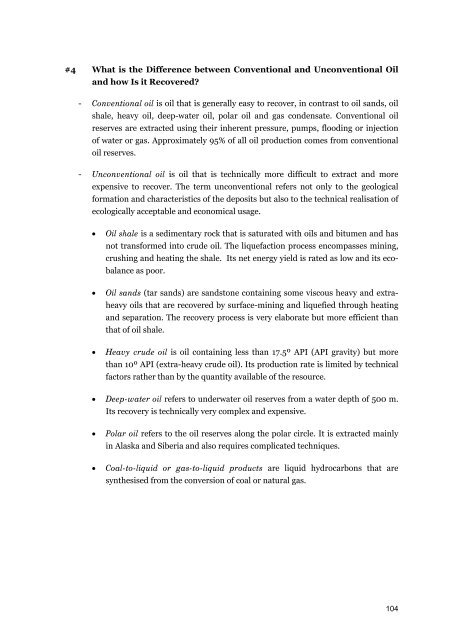PEAK OIL
PEAK OIL
PEAK OIL
Create successful ePaper yourself
Turn your PDF publications into a flip-book with our unique Google optimized e-Paper software.
#4 What is the Difference between Conventional and Unconventional Oil<br />
and how Is it Recovered?<br />
- Conventional oil is oil that is generally easy to recover, in contrast to oil sands, oil<br />
shale, heavy oil, deep-water oil, polar oil and gas condensate. Conventional oil<br />
reserves are extracted using their inherent pressure, pumps, flooding or injection<br />
of water or gas. Approximately 95% of all oil production comes from conventional<br />
oil reserves.<br />
- Unconventional oil is oil that is technically more difficult to extract and more<br />
expensive to recover. The term unconventional refers not only to the geological<br />
formation and characteristics of the deposits but also to the technical realisation of<br />
ecologically acceptable and economical usage.<br />
Oil shale is a sedimentary rock that is saturated with oils and bitumen and has<br />
not transformed into crude oil. The liquefaction process encompasses mining,<br />
crushing and heating the shale. Its net energy yield is rated as low and its ecobalance<br />
as poor.<br />
Oil sands (tar sands) are sandstone containing some viscous heavy and extraheavy<br />
oils that are recovered by surface-mining and liquefied through heating<br />
and separation. The recovery process is very elaborate but more efficient than<br />
that of oil shale.<br />
Heavy crude oil is oil containing less than 17.5º API (API gravity) but more<br />
than 10º API (extra-heavy crude oil). Its production rate is limited by technical<br />
factors rather than by the quantity available of the resource.<br />
Deep-water oil refers to underwater oil reserves from a water depth of 500 m.<br />
Its recovery is technically very complex and expensive.<br />
Polar oil refers to the oil reserves along the polar circle. It is extracted mainly<br />
in Alaska and Siberia and also requires complicated techniques.<br />
Coal-to-liquid or gas-to-liquid products are liquid hydrocarbons that are<br />
synthesised from the conversion of coal or natural gas.<br />
104


